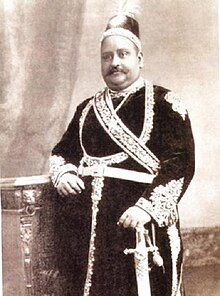
Back زميندار Arabic জমিদার Bengali/Bangla Zamindar Catalan Zamindar German Zamindar Spanish زمیندار Persian Zamindari Finnish Zamindar French ज़मींदार Hindi Զամինդարի Armenian
This article possibly contains original research. (December 2022) |

A zamindar[a] in the Indian subcontinent was an autonomous or semi-autonomous feudal ruler of a zamindari (feudal estate). The term itself came into use during the reign of Mughals, Marathas and later the British had begun using it as a native synonym for "estate". The term means landowner in Persian. They were typically hereditary, and held the right to collect tax on behalf of imperial courts or for military purposes.
During the period of British colonial rule in India many wealthy and influential zamindars were bestowed with princely and royal titles such as Maharaja, Raja/Rai, Babu, Malik, Chaudhary, Nawab, Khan and Sardar.
During the Mughal Empire, zamindars belonged to the nobility[1] and formed the ruling class. Emperor Akbar granted them mansabs and their ancestral domains were treated as jagirs.[2] Some zamindars were Hindu by religion and usually Brahmin, Bhumihar, Kayastha, Rajput and Jat Sikh landlords by caste.[3][4][5][6] During the colonial era, the Permanent Settlement consolidated what became known as the zamindari system. The British rewarded supportive zamindars by recognising them as princes. Many of the region's princely states were pre-colonial zamindar holdings elevated to a greater protocol. The British also reduced the land holdings of many pre-colonial princely states and chieftaincy, demoting their status to a zamindar from previously higher ranks of royalty.[citation needed]

The system was abolished during land reforms in East Pakistan (Bangladesh) in 1950,[7] India in 1951[8] and West Pakistan in 1959.[9]
The zamindars often played an important role in the regional histories of the subcontinent. One of the most notable examples is the 16th-century confederation formed by twelve zamindars in the Bhati region (Baro-Bhuyans), which, according to the Jesuits and Ralph Fitch, earned a reputation for successively repelling Mughal invasions through naval battles. The zamindars were also patrons of the arts. The Tagore family produced India's first Nobel laureate in literature in 1913, Rabindranath Tagore, who was often based at his estate. The zamindars also promoted neoclassical and Indo-Saracenic architecture.
Cite error: There are <ref group=lower-alpha> tags or {{efn}} templates on this page, but the references will not show without a {{reflist|group=lower-alpha}} template or {{notelist}} template (see the help page).
- ^ Metcalf, Barbara Daly (1984). Moral conduct and authority: the place of adab in South Asian Islam. University of California Press. p. 269. ISBN 9780520046603. Archived from the original on 8 March 2023. Retrieved 15 November 2015.
- ^ Acharya, Shreya (30 October 2011). "Give an account of the Ruling Classes of Mughal Empire". preservearticles.com. Archived from the original on 21 May 2013.
- ^ Choithani, Chetan (11 May 2023). Migration, Food Security and Development. Cambridge University Press. p. 106. ISBN 978-1-108-84037-8.
- ^ Khan, Zahoor Ali (1997). "ZAMINDARI CASTE CONFIGURATION IN THE PUNJAB, c.1595 — MAPPING THE DATA IN THE "A'IN-I AKBARI"". Proceedings of the Indian History Congress. 58: 334–341. ISSN 2249-1937. JSTOR 44143925.
The number of parganas with Jat zamindaris is surpris-ingly large and well spread out, though there are none beyond the Jhelum. They appear to be in two blocks, divided by a sparse zone between the Sutlej and the Sarasvati basin. The two blocks, in fact, represent two different segments of the Jats, the western one (Panjab) known as Jat (with short vowel) and the other (Haryanvi) as Jaat (with long vowel), though the A 'in-i Akbari has the same spelling for their names ('Jat' with short vowel). It was the western segment, which became the back-bone of the Sikh Panth in the seventeenth century, as was noted by the author of the Dabistan-i Mazahib in c.1653.9 That the Jats already held zamindari rights in a number of parganas in the Panjab was possibly one reason why their support to Sikhism proved to be especially effective
- ^ Mooney, Nicola (2013). "The Yeoman Jats of Punjab: Time, Expertise and the Colonial Construction of Jat Sikh Identity". Anthropologica. 55 (2): 277–290. ISSN 0003-5459. JSTOR 24467328.
- ^ Mooney, Nicola (31 January 2011). Rural Nostalgias and Transnational Dreams: Identity and Modernity Among Jat Sikhs. Toronto: University of Toronto Press. doi:10.3138/9781442694934-005. ISBN 978-1-4426-9493-4.
Renowned as the predominant farmers and landlords of Punjab, and long possessed of an autocthonous agricultural identity, Jat Sikhs today often live urban and diasporiclives. Rural Nostalgias and Transnational Dreams examines the formation and meaning of Jat Sikh identity in the contemporary Indian city.
Nicola Mooney describes a number of Jat Sikh social practices and narratives through which contemporary notions of identity are developed. She contextualizes these elements of Jat Sikh modernity against local, regional, and national histories of cultural and political differentiation, perceptions of marginality, and the expression of increasingly exclusive notions and practices of identity. This unique ethnography incorporates first-hand observations and local narratives to develop insights into the traditions and social memory of Jat Sikhs, as well as on the issues of urban and transnational social transformation. - ^ Baxter, C (1997). Bangladesh, from a Nation to a State. Westview Press. p. 72. ISBN 0-8133-3632-5.
- ^ "Abolition of Zamindari in India". gktoday.in. General Knowledge Today. Archived from the original on 30 November 2016.
- ^ "Land reforms in Pakistan". Dawn.com. 11 October 2010. Archived from the original on 30 November 2016.
© MMXXIII Rich X Search. We shall prevail. All rights reserved. Rich X Search